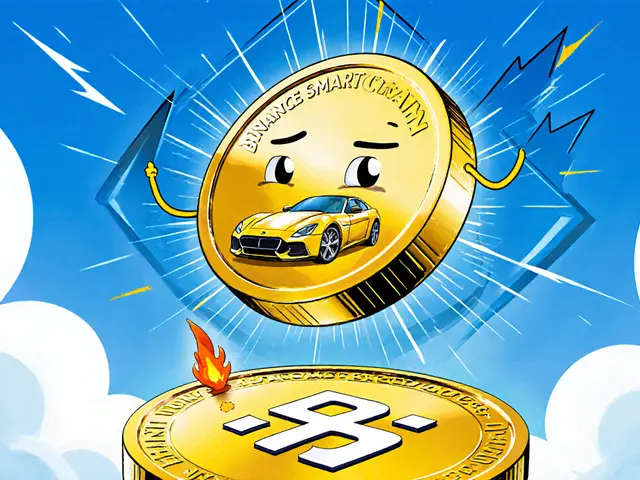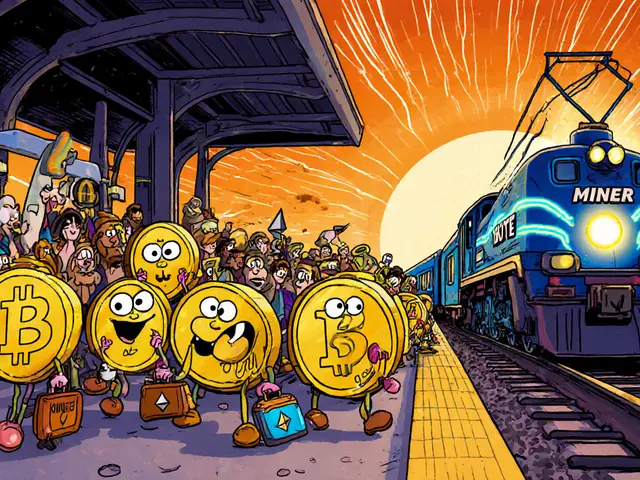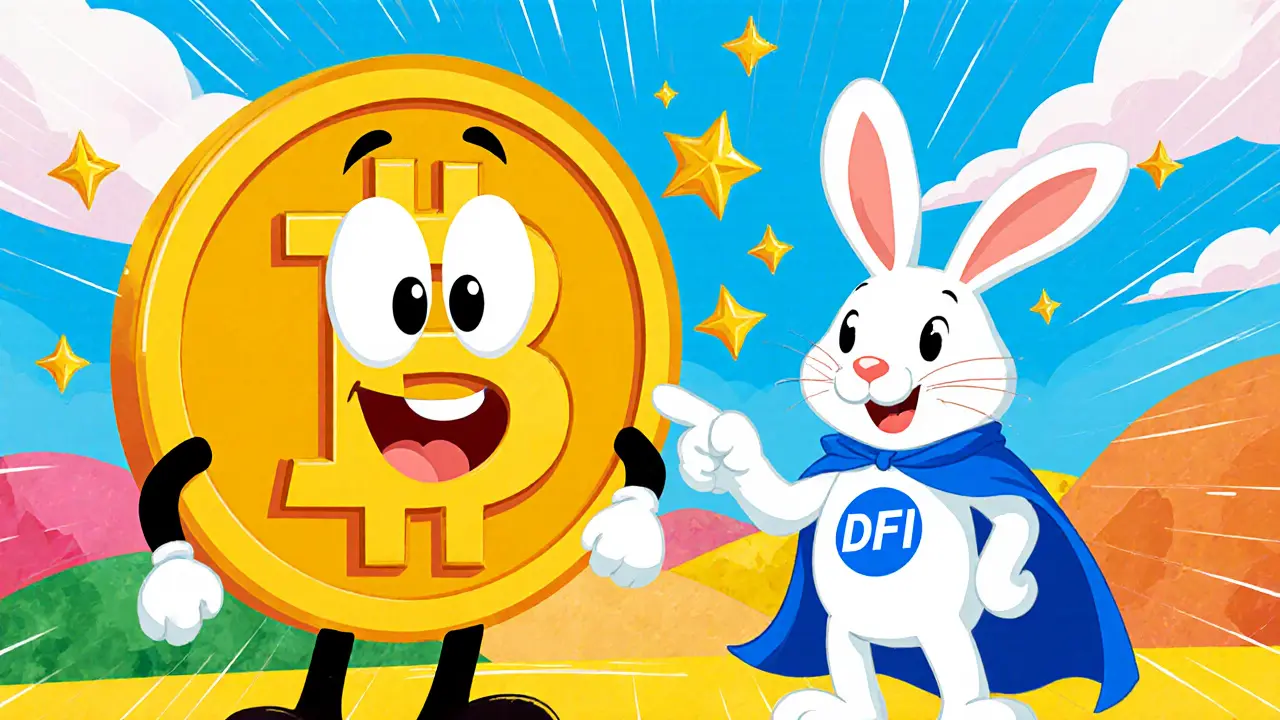
DeFiChain Staking Calculator
Calculate Your DeFiChain Staking Rewards
Estimate your annual returns based on current staking rates (5-7% annualized).
How it works: You lock a minimum of 10 DFI in a masternode. The network distributes a portion of block rewards and transaction fees to all staking participants, proportionate to the amount staked. Current annualized rewards range from 5-7% depending on network participation.
Key Staking Info
- Minimum Staking Amount: 10 DFI
- Annualized Return: 5-7%
- Staking Benefits: Earn rewards + voting rights
- Current DFI Price: ~$0.0015-$0.0020
When you hear “DeFi” most people picture Ethereum, but there’s a Bitcoin‑native alternative that many investors overlook: DeFiChain. Launched in 2019, DeFiChain (tickerDFI) builds a full suite of decentralized finance services on top of the Bitcoin ecosystem, aiming to give Bitcoin holders the same yield‑generating tools they find on other blockchains without having to move off‑chain.
What DeFiChain Actually Is
DeFiChain is a fork of Bitcoin’s codebase that adds a layer for financial smart contracts while still anchoring regularly to the Bitcoin blockchain. Every few blocks the network posts a Merkle root to Bitcoin, which means every transaction on DeFiChain inherits Bitcoin’s proof‑of‑work security. Unlike Ethereum’s Turing‑complete contracts, DeFiChain’s scripting language is deliberately limited to financial operations, reducing the chance of bugs that could lock or lose funds.
How the Platform Works
The backbone of DeFiChain is a proof‑of‑stake (PoS) consensus model. DFI holders lock (stake) their tokens in a validator node, earning a share of transaction fees and newly minted rewards. Those rewards are split between validators and the community fund, which finances ongoing development.
Two technical tricks set DeFiChain apart:
- Bitcoin anchoring: By committing a Merkle root to Bitcoin every few blocks, the network inherits Bitcoin’s immutable ledger, making attacks extremely costly.
- Non‑Turing‑complete design: The language only supports financial primitives-lending, swapping, tokenizing-so the network stays fast and cheap.
DFI Token Mechanics
The DFI token is the lifeblood of the ecosystem. It serves four core purposes:
- Transaction fees: Every trade on the built‑in DEX, every asset transfer, and every oracle query pays a tiny fee in DFI.
- Collateral: Borrowers lock DFI (or wrapped assets) to open loans, providing the safety net for lenders.
- Staking: Validators stake DFI to secure the network and earn rewards proportional to their stake.
- Governance: Token holders vote on protocol upgrades, fee adjustments, and community fund allocations.
Supply‑side facts: maximum supply is 1.2billion DFI, with roughly 600million already circulating. The token distribution avoided any public sale; about 49% went directly to the DeFiChain Foundation (capped by contract to prevent centralization) and the rest to early investors and partners.
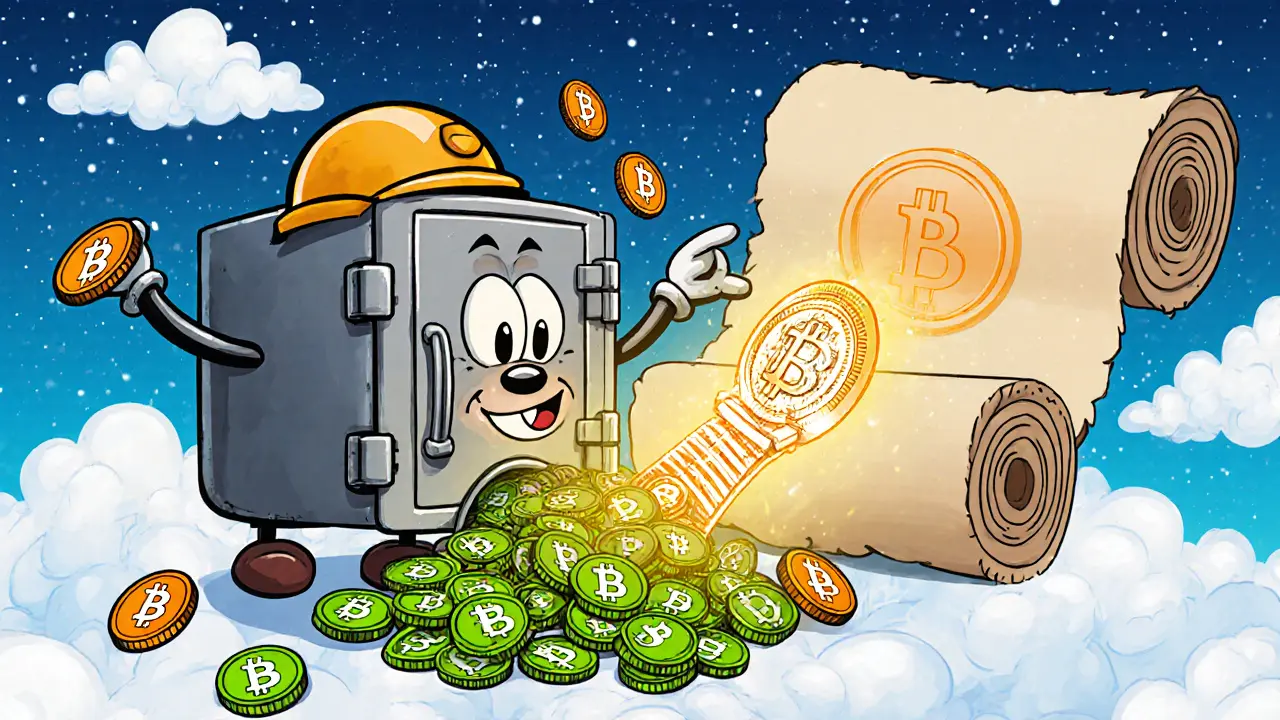
Key Features & Services
DeFiChain offers a full DeFi stack without leaving Bitcoin:
- Decentralized exchange (DEX) - native, low‑fee swapping of DFI, BTC, ETH, and dozens of wrapped tokens.
- Liquidity mining - providers earn extra DFI for supplying pool depth.
- Token wrapping - BTC, ETH, ERC‑20, and other assets can be wrapped 1:1 to operate on DeFiChain without a trusted custodial bridge.
- Decentralized lending - borrowers receive stablecoins or other assets while lenders earn interest, all backed by collateral.
- Oracles - price feeds ensure accurate valuation for loans and swaps.
All of these services are designed to be permissionless: anyone can become a validator, a liquidity provider, or a borrower as long as they meet the collateral requirements.
DeFiChain vs. Ethereum‑Based DeFi
| Feature | DeFiChain | Ethereum DeFi |
|---|---|---|
| Base Layer Security | Anchored to Bitcoin’s PoW | Ethereum PoS (post‑merge) |
| Smart‑Contract Model | Non‑Turing‑complete, finance‑only | Turing‑complete, general purpose |
| Typical Transaction Cost | ~$0.001‑$0.005 | ~$0.20‑$5.00 (varies wildly) |
| Speed (seconds per block) | ~30s | ~12s (average) |
| Primary Audience | Bitcoin holders seeking DeFi | General crypto users & developers |
| Governance Token | DFI | Various (e.g., COMP, AAVE) |
In short, DeFiChain trades flexibility for security and cost‑efficiency. If you already own Bitcoin and want to earn yield without bridging to another chain, DeFiChain’s low fees and Bitcoin‑anchored security are compelling. If you need complex contracts, NFTs, or broader composability, Ethereum still leads.
How to Get Started with DFI
Getting DFI into your wallet is a three‑step process:
- Choose a supported exchange (e.g., KuCoin, Bittrex, Huobi). Create an account and complete KYC if required.
- Buy DFI using USD, BTC, or another crypto pair. Prices hover around $0.0015‑$0.0020 as of October2025.
- Transfer the tokens to a compatible wallet (DeFiChain’s official DeFiChain Wallet or Ledger hardware). Once in the wallet, you can stake, swap, or provide liquidity directly.
To stake, navigate to the “Masternodes” tab, lock a minimum of 10DFI, and start earning a share of block rewards (roughly 5‑7% annualized, depending on network participation). Staking also gives you voting rights on upcoming protocol proposals.
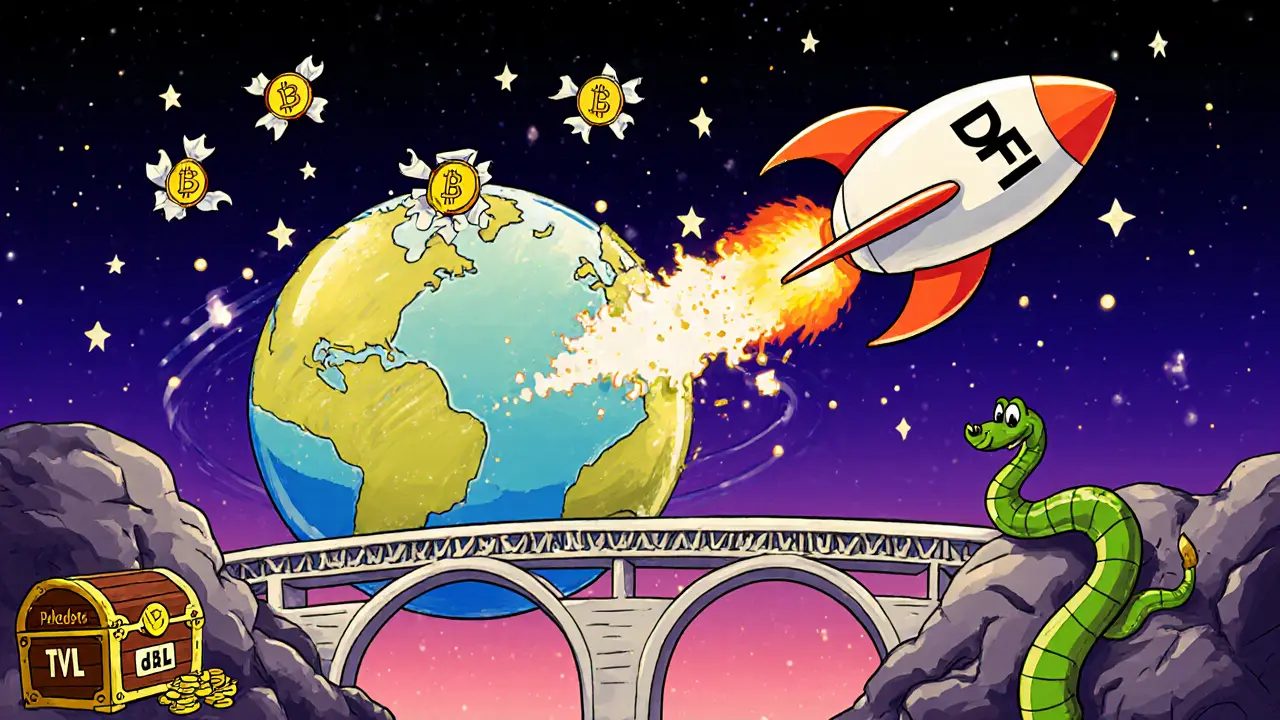
Future Roadmap and Development Outlook
The DeFiChain team has a clear set of milestones for the next two years:
- Transferable debt tokens: Allow users to trade debt positions on the secondary market, increasing liquidity for borrowers.
- Non‑collateralized credit: Introduce reputation‑based lending for trusted users, expanding the borrower base.
- Advanced yield farming: New LP incentives for emerging token pairs, aiming to grow TVL beyond $1billion.
- Cross‑chain bridges: Partnerships with Polkadot and Cosmos to enable seamless asset movement while keeping the core Bitcoin‑anchored security model.
Active development is visible on GitHub (github.com/DeFiCh/ain) with weekly commits, and community updates flow through the official Twitter, Reddit, and Telegram channels.
Potential Risks to Consider
While DeFiChain’s design mitigates many smart‑contract risks, investors should be aware of a few challenges:
- Network effect: Ethereum’s massive developer community still dwarfs DeFiChain, limiting the number of dApps.
- Liquidity depth: Some smaller pools can experience price slippage during large trades.
- Regulatory exposure: As a Bitcoin‑based DeFi platform, it may attract scrutiny from regulators targeting Bitcoin’s use in financial services.
Balancing these factors against the platform’s low fees and strong security helps you decide whether DFI fits your portfolio.
Frequently Asked Questions
What is the main advantage of DeFiChain over Ethereum?
DeFiChain offers Bitcoin‑anchored security and far lower transaction costs, making it ideal for Bitcoin holders who want DeFi services without high fees.
How does staking work on DeFiChain?
You lock a minimum of 10DFI in a masternode. The network distributes a portion of block rewards and transaction fees to all staking participants, proportionate to the amount staked.
Can I use Bitcoin directly on DeFiChain?
Yes. Bitcoin can be wrapped 1:1 as dBTC on DeFiChain, allowing it to participate in swaps, lending, and liquidity pools without leaving the Bitcoin ecosystem.
Where can I buy DFI?
Major exchanges such as KuCoin, Bittrex, and Huobi list DFI. After purchase, transfer the tokens to a DeFiChain‑compatible wallet for staking or trading.
What is the total value locked (TVL) on DeFiChain?
As of October2025, DeFiChain’s TVL exceeds $600million, reflecting strong adoption of its lending and DEX services.



